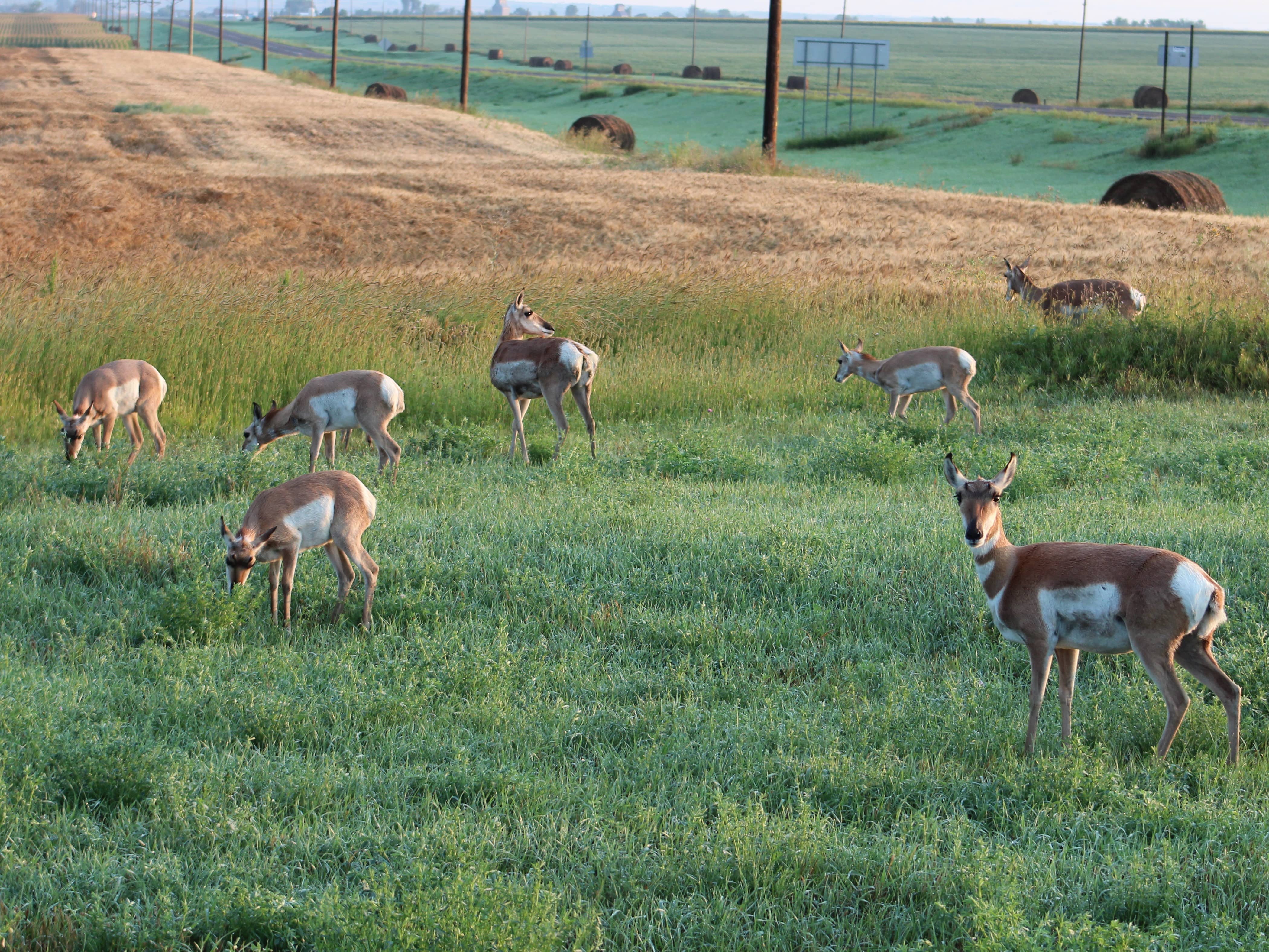
Pronghorn does and fawns forage in a grassy strip along a highway. The doe-to-fawn ratio was down in aerial surveys conducted by the NDG&F Dept., and young pronghorns likely suffered predation from coyotes, worsened by lack of cover on a dry landscape this spring. Simonson Photo.
By Nick Simonson
Dry conditions which began last fall and persisted through the winter and spring left less cover on the landscape for North Dakota’s recovering pronghorn populations heading into summer.
As a result, agents from the North Dakota Game & Fish Department (NDG&F) saw fewer young pronghorns with adult does as part of their annual survey and suspect the lack of spring regrowth and struggling rangeland conditions were likely the culprit, as fawns lacked the cover to hide from predators on the landscape.
“The numbers are fair to down, I think we had some EHD impacts with them, along with this drought and a lack of residual cover, coyotes are picking them off out there,” said Jason Smith, NDG&F Big Game Biologist who spent approximately thirty hours in the air for the pronghorn survey. “I flew up there – Montana line all the way south to Trotters, along the lake and all the way down – and I had an area that was down by half, one that was the same, one that was up just a little bit and one that was down,” he concluded.
The surveys are conducted by flying airplanes low over the animals’ range in western North Dakota in early summer and tallying the number of pronghorn seen and the gender and approximate age. This year, those samples suggested an eight percent decline overall in animals observed when compared to the 2020 survey. This year’s ratio of fawns-to-does fell to 52-to-100, compared to 61-to-100 in 2020. Bucks-to-does averaged 34-to-100 in this year’s aerial survey which was comparable to last year’s ratio of 35-to-100, with both being above the population objectives managed for by the NDG&F.
The number of licenses available for this fall’s hunting season is 1,720, off slightly from 2020’s total of 1,790 which was a significant jump from the previous year’s 1,330. In 2020, three units were reopened to pronghorn hunting after being closed since populations began to decline following to the harsh winters of 2009 and 2010.
“Most of the drop in licenses occurred down in the extreme southwest part of the state in hunting unit 4-A and this was an area that did experience more widespread population decline,” says Bruce Stillings, NDG&F Big Game Management Supervisor, adding, “talking to biologists in Montana and South Dakota, that whole general area saw more of a reduction than some of the other areas.”
Going behind the numbers, long-lasting impacts to habitat brought on by the drought in the state’s pronghorn range placed this year’s pronghorn fawns in dangerous situations and made them easy prey for their primary predator, the coyote.
Especially where the young pronghorns are exposed and not easily mobile right after birth, the opportunistic canines are more able to find the fawns and impact populations. With minimal late summer and autumn rain and no regrowth heading into winter coupled virtually no snow across the western portion of the state limiting spring plant growth, fawns were often left in the open and susceptible.
“Those does a lot of times are dropping those fawns in areas that it’s just about like taking a white cue ball and putting it on a pool table and trying to hide them from predators, and that’s pretty tough to do, that’s the biggest reason for the low fawn-to-doe ratio this summer,” Stillings explained.
Additionally, last year’s significant EHD outbreak also cut into the pre-fawning population of pronghorns across all age classes as the agency confirmed a number of pronghorn deaths last fall from epizootic hemorrhagic disease (EHD), a midge-borne illness which primarily affects whitetailed deer in western North Dakota, but can impact other big game species including mule deer, elk and pronghorn. While the prevalence may be the same across big game species in terms of infection, whitetailed deer are just more sensitive to its effects, where mule deer, pronghorn and elk usually aren’t affected as badly and don’t typically die.
However, last year Stillings stated he had confirmed more pronghorn deaths from EHD than in any season prior, suggesting the outbreak was severe and the biting midges which transfer the disease were plentiful. Despite both the poor rangeland conditions and the impact EHD may have had, numbers are generally good and the population of pronghorns has not slipped into a rebuilding phase and hunting opportunities remain.
The 2021 pronghorn hunting season is split into two portions. First an archery season runs from noon on Sept. 3 until Sept. 26.
The season then closes and is reopened at noon on Oct. 1 where hunters can utilize both archery equipment and firearms until Oct. 17. Only North Dakota residents can apply in the state’s lottery for one of the 1,720 tags across 15 open units, and the deadline to do so is Aug. 11.
Applications can be completed online at gf.nd.gov/buy-apply.
